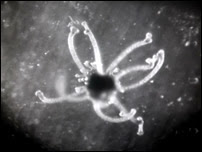Le sang des bêtes
"The slaughterhouse is linked to religion in so far as the temples of bygone eras (not to mention those of the Hindus in our own day) served two purposes: they were used both for prayer and for killing. The result (and this judgement is confirmed by the chaotic aspect of present-day slaughterhouses) was certainly a disturbing convergence of the mysteries of myth and the ominous grandeur typical of those places in which blood flows. In America, curiously enough, W. B. Seabrook has expressed an intense regret; observing that the orgiastic life has survived, but that the sacrificial blood is not part of the cocktail mix, he finds present custom insipid. In our time, nevertheless, the slaughterhouse is cursed and quarantined like a plague-ridden ship. Now, the victims of this curse are neither butchers nor beasts, but those same good folk who countenance, by now, only their own unseemliness, an unseemliness commensurate with an unhealthy need of cleanliness, with irascible meanness, and boredom. The curse (terrifying only to those who utter it) leads them to vegetate as far as possible from the slaughterhouse, to exile themselves, out of propriety, to a flabby world in which nothing fearful remains and in which, subject to the ineradicable obsession of shame, they are reduced to eating cheese".
Georges Bataille - "Abbatoir", Documents 6, 1929.
http://surrealdocuments.blogspot.com/2007/08/georges-franju-le-sang-des-btes.htmlPoco tengo para decir de este documento, pues mantuve los ojos cerrados durante gran parte de la proyección. No me gusta ver animales sufriendo, y creo que hay imágenes que no quiero tener en mi cabeza, una de tantas son las que Georges Franju muestra.
Clair Clouzot described Fraju's film style it as "a poignant fantastic realism inherited from surrealism and Jean Painlevé science cinema, and influenced by the expressionism of Lang and Murnau".[6] Franju's focus on the film was on visuals which he claimed marked a director as an auteur. Franju claimed to "not have the story writing gift" and was focused on what he described as the "putting into form" of the film.[7]
Franju states that he wasn't interested on the subject of slaughterhouses when he decided to make the film, but the location around the building was the Ourcq Canal allowing him to make a documentary film. Franju stated by using a documentary film format, he was able to use both locations as lyical counterpoints and "to explain it as a realist while remaining a surrealist by displacing the object in another context. In this new setting, the object rediscovers it's quality as an object".
IMPORTANTE: Georges Franju fue uno de los fundadores junto a Henri Langlois de la Cinemateca.
"Brillante, maestra y aterradora, La sangre de las bestias es, quizás, la mejor obra en relación con el horror del holocausto y nuestra posición como espectadores externos de tal espectáculo de imágenes y documentos reales que, sin plantearnos su contendio, hemos aceptado sin tener en cuenta el proceso moral de estos."





No hay comentarios:
Publicar un comentario